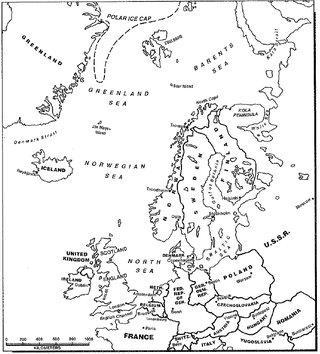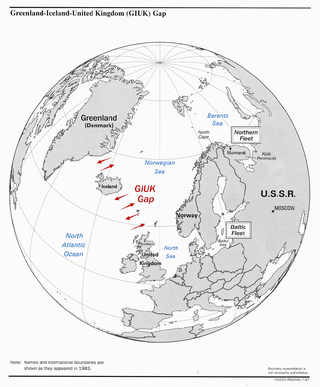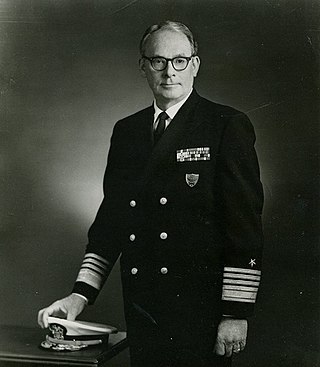Supreme Allied Commander is the title held by the most senior commander within certain multinational military alliances. It originated as a term used by the Allies during World War I, and is currently used only within NATO for Supreme Allied Commander Europe and Supreme Allied Commander Transformation.

The Supreme Headquarters Allied Powers Europe (SHAPE) is the military headquarters of the North Atlantic Treaty Organization's (NATO) Allied Command Operations (ACO) that commands all NATO operations worldwide. SHAPE is situated in the village of Casteau, near Mons, Belgium.

The United States Second Fleet is a numbered fleet in the United States Navy responsible for operations in the East Coast and North Atlantic Ocean. Established after World War II, Second Fleet was deactivated in 2011, when the United States government believed that Russia's military threat had diminished, and reestablished in 2018 amid renewed tensions between NATO and Russia.

Allied Joint Force Command Brunssum (JFCBS) is a NATO command with its headquarters at Brunssum, the Netherlands. It was established in 2004, as part of a reorganisation that reduced the number of NATO Military Command Structure headquarters.
Allied Command Operations (ACO) is one of the two strategic commands of the North Atlantic Treaty Organization (NATO), the other being Allied Command Transformation (ACT). The headquarters and commander of ACO is Supreme Headquarters Allied Powers Europe (SHAPE) and Supreme Allied Commander Europe (SACEUR), respectively.

Standing NATO Maritime Group One (SNMG1) is one of NATO's standing naval maritime immediate reaction forces. SNMG1 consists of four to six destroyers and frigates. Its role is to provide NATO with an immediate operational response capability.

The United States Naval Forces Europe and Africa (NAVEUR-NAVAF), is the United States Navy component command of the United States European Command and United States Africa Command. Prior to 2020, NAVEUR-NAVAF was previously referred to as United States Naval Forces Europe – Naval Forces Africa and sometimes referred to as United States Naval Forces Europe – Africa.

Allied Command Transformation (ACT) is a military command of the North Atlantic Treaty Organization (NATO), formed in 2003 after restructuring.

Northwood Headquarters is a military headquarters facility of the British Armed Forces in Eastbury, Hertfordshire, England, adjacent to the London suburb of Northwood. It is home to the following military command and control functions:
- Headquarters, Strategic Command, formerly Joint Forces Command
- Permanent Joint Headquarters
- Commander Operations for the Royal Navy
- NATO Allied Maritime Command

The Joint Force CommandNaples is a NATO military command based in Lago Patria, in the Metropolitan City of Naples, Italy. It was activated on 15 March 2004, after effectively redesigning its predecessor command, Allied Forces Southern Europe (AFSOUTH), originally formed in 1951. In NATO Military Command Structure terms, AFSOUTH was a "Major Subordinate Command". The commander of JFC Naples reports to the Supreme Allied Commander Europe at the Supreme Headquarters Allied Powers Europe, Casteau, Belgium.

The Supreme Allied Commander Atlantic (SACLANT) was one of two supreme commanders of the North Atlantic Treaty Organisation (NATO), the other being the Supreme Allied Commander Europe (SACEUR). The SACLANT led Allied Command Atlantic was based at Norfolk, Virginia. The entire command was routinely referred to as 'SACLANT'.

Exercise Mainbrace was the first large-scale naval exercise undertaken by the newly established Allied Command Atlantic (ACLANT), one of the two principal military commands of the North Atlantic Treaty Organization (NATO). It was part of a series of NATO exercises jointly commanded by Supreme Allied Commander Atlantic Admiral Lynde D. McCormick, USN, and Supreme Allied Commander Europe General Matthew B. Ridgeway, U.S. Army, during the fall of 1952.

Lynde Dupuy McCormick was a four-star admiral in the United States Navy who served as vice chief of naval operations from 1950 to 1951 and as commander in chief of the United States Atlantic Fleet from 1951 to 1954, and was the first supreme allied commander of all NATO forces in the Atlantic.

Exercise Strikeback aka Operation Strikeback was a major naval exercise of the North Atlantic Treaty Organization (NATO) that took place over a ten-day period in September 1957.

Richard Gary Colbert was a four-star admiral in the United States Navy who served as President of the Naval War College from 1968 to 1971, and as commander in chief of all NATO forces in southern Europe from 1972 to 1973. He was nicknamed "Mr. International Navy" as one of the very few senior admirals in the U.S. Navy identified with international naval cooperation during the Cold War.

Bruce Waid Clingan is a retired United States Navy admiral who last served as Commander of United States Naval Forces Europe, United States Naval Forces Africa and Allied Joint Force Command Naples from February 24, 2012 to July 22, 2014. He previously served as Deputy Chief of Naval Operations for Operations, Plans and Strategy and Commander, United States Sixth Fleet, as well as Commander, Joint Command Lisbon from August 2008 to November 2009. He retired from the Navy in the fall of 2014 after over 37 years of service.
The Structure of the North Atlantic Treaty Organization is complex and multi-faceted. The decision-making body is the North Atlantic Council (NAC), and the member state representatives also sit on the Defence Policy and Planning Committee (DPPC) and the Nuclear Planning Group (NPG). Below that the Secretary General of NATO directs the civilian International Staff, that is divided into administrative divisions, offices and other organizations. Also responsible to the NAC, DPPC, and NPG are a host of committees that supervise the various NATO logistics and standardisation agencies.

The Allied Maritime Command (MARCOM) is the central command of all NATO maritime forces and the Commander MARCOM is the prime maritime advisor to the Alliance. When directed by the Supreme Allied Commander Europe (SACEUR), it provides the core of the headquarters responsible for the conduct of maritime operations. The command is based at the Northwood Headquarters in Eastbury, Hertfordshire.

Allied Command Channel (ACCHAN) was one of three major North Atlantic Treaty Organization (NATO) commands from 1952 to 1994. Commander-in-Chief Channel was a Major NATO Commander (MNC).

The history of the North Atlantic Treaty Organization (NATO) begins in the immediate aftermath of World War II when British diplomacy set the stage to contain the Soviet Union and to stop the expansion of Soviet power in Europe. The United Kingdom and France signed, in 1947, the Treaty of Dunkirk, a defensive pact, which was expanded in 1948 with the Treaty of Brussels to add the three Benelux countries and committed them to collective defense against an armed attack for fifty years. The British worked with Washington to expand the alliance into NATO in 1949, adding the United States and Canada as well as Italy, Portugal, Norway, Denmark, and Iceland. Greece and Turkey joined in 1952, West Germany joined in 1955, Spain joined in 1982, Czech Republic, Hungary and Poland joined in 1999, Bulgaria, Estonia, Latvia, Lithuania, Romania, Slovakia, and Slovenia joined in 2004, Albania and Croatia joined in 2009, Montenegro joined in 2017, North Macedonia joined in 2020, and Finland joined in 2023.

















